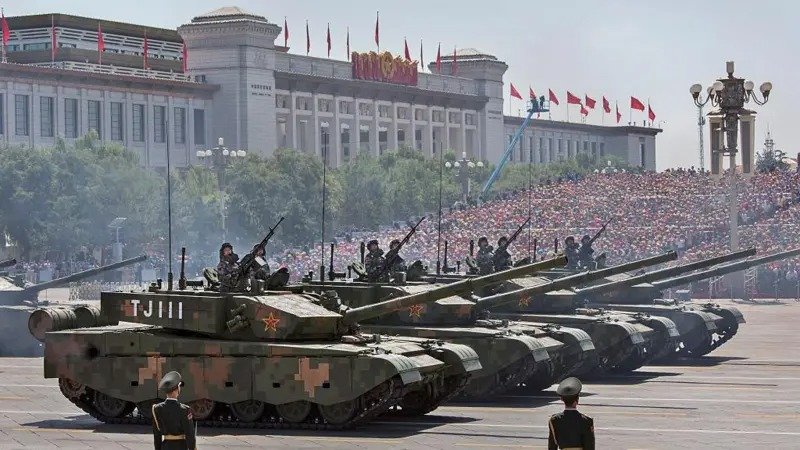
China’s 9/3 Military Parade: A Show of Force That Strengthens U.S. and Allied Resolve
Beijing is preparing for a massive military parade on September 3 to mark the 80th anniversary of the victory in World War II. Officially, the event is billed as a commemoration of the “War of Resistance Against Japan” and a display of “peace through strength.” In reality, it is a costly spectacle designed to project power abroad and consolidate control at home. The real consequence of this display will not be intimidation but rather renewed determination among the United States and its democratic allies to strengthen defense cooperation and counter China’s aggressive posture.
According to Chinese state media, the parade will mobilize more than 10,000 troops, hundreds of military vehicles, and over 100 aircraft. New weapons expected to be revealed include hypersonic missiles, stealth fighters such as the J-20 and J-35, advanced airborne early warning aircraft, and swarms of drones designed for “loyal wingman” operations. Beijing has even shut down airspace across seven districts of the capital and closed Tiananmen Square for several days to secure the parade area.
The sheer scale and expense highlight how far China is willing to go to project an image of unstoppable power. But for all the carefully choreographed displays, the underlying message is not stability or peace—it is coercion.
China has long used parades to send signals to its neighbors and the international community. Yet history demonstrates that these shows of force often produce the opposite of Beijing’s intended effect.
The upcoming parade will be watched carefully in Washington, Tokyo, Seoul, Canberra, and across Europe. Far from discouraging democratic nations, Beijing’s saber-rattling serves as a catalyst for allied cooperation.
Simply put, every time China stages a parade of “unstoppable” power, it provides new justification for the United States and its allies to accelerate cooperation and strengthen deterrence.
The weapons to be showcased are not merely ceremonial. Hypersonic missiles capable of maneuvering at extreme speeds are designed to penetrate U.S. missile defenses. New drones modeled on American platforms, including “loyal wingman” systems, signal China’s ambition to pair manned and unmanned aircraft in future conflicts.
For the United States, this means that Beijing is developing tools specifically aimed at challenging U.S. naval dominance in the Pacific and threatening American bases in Guam, Hawaii, and beyond. The U.S. military cannot afford to dismiss the parade as mere theater; it is also an unveiling of technologies intended to target American service members in the event of conflict.
Despite the parade’s scale, the event cannot conceal China’s internal fragilities. The economy is slowing, youth unemployment has spiked, and property markets remain unstable. State resources are being drained to fund grandiose displays instead of addressing real social and economic problems.
This disconnect is why U.S. and allied analysts view the parade as more political theater than military milestone. It is intended to project unity and strength to a domestic audience even as the regime grapples with corruption, slowing growth, and discontent. But this illusion comes at a cost: it reinforces to the outside world that Beijing prioritizes military intimidation over constructive engagement.
For U.S. citizens, the significance of the parade extends beyond symbolic pageantry in Beijing. Every dollar Beijing invests in hypersonic missiles or electronic warfare units is aimed at undermining America’s security guarantees to its allies. Every drone or stealth jet paraded through Tiananmen Square is intended as a signal to Washington that China is preparing for confrontation.
The danger for the United States is clear: ignoring these signals could leave American forces and allies vulnerable. By recognizing the true intent behind Beijing’s military showcase, Americans can better understand why strengthening alliances, maintaining forward deployments, and investing in next-generation defense systems are essential.
China’s September 3 parade will showcase advanced weapons and orchestrated formations designed to impress domestic audiences and intimidate foreign observers. But for the United States and its democratic partners, the parade is not a deterrent—it is a warning.
Rather than dividing the democratic world, China’s aggression unites it. From Guam to Tokyo, from Seoul to Canberra, and increasingly in European capitals, the conclusion is the same: Beijing’s displays of power require stronger defense cooperation.
By attempting to intimidate, China ensures the opposite—greater unity among the United States and its allies. For Americans, the lesson is straightforward: vigilance is not optional, it is necessary. The parade may last only 70 minutes, but its consequences for global security will resonate for years to come.